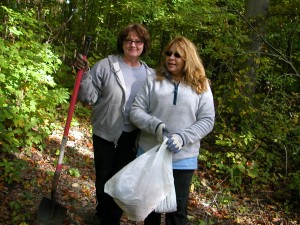When the bulldozers arrive to scrape a woodland, drain a wetland, or erase a prairie, it can be heartbreaking to realize what’s being lost to the ecosystem. Despite our best efforts at conservation and protection, sometimes all we can do is rescue the plants slated to be destroyed.
With enough prior notice, your Indiana Native Plant Society chapter leaders can assemble a group of volunteers to dig native plants before the bulldozers arrive. The rescued plants find new life as they are shared half-and-half with the rescue volunteers and the INPS Plant Sale & Auction or regional chapter plant sales.
Plant Rescue Protocol
Native plant rescue is a great opportunity to save native plants from destruction, but this activity can also involve risks. INPS has developed these guidelines to ensure that rescues are done in a legal, ethical, and successful way.
1. Obtain permission to visit. Once you’ve heard about a site that will have native plants destroyed because of development, it is most important to get the landowner’s verbal permission to visit the site. Explain that you understand the site is going to be developed and that you are possibly interested in doing a native plant rescue on the site. Ask for permission to visit and evaluate the site and let the owner know that you are just looking—if the site is appropriate for a native plant rescue you will be back in touch for permission. If the owner says no, that is the end of the matter—you cannot visit the site without permission.
2. Evaluate the site. Not all sites are appropriate for plant rescue. First, scout the site to assure that it is not infested with invasive plant species like garlic mustard or Japanese stilt grass. Seeds from these species could inadvertently be moved from the site and spread widely through the rescue effort. Second, make a list of the native species that are salvageable. Keep in mind that spring ephemerals need to be salvaged before the end of May or nothing will remain above ground to indicate where to dig. Third, evaluate parking and access to find the easiest way to get people in and out of the site—pots full of dirt get very heavy!
3. Obtain permission to do a native plant rescue. If the site has salvageable native plants, and is not infested with invasive plants, approach the landowner for permission to do the plant rescue. The owner needs to sign a permission form granting the rescue team leave to enter their property and dig and remove plants. If the owner will not sign, the rescue cannot proceed. For help in approaching the landowner, contact your chapter leader.
4. Map and verify. After receiving permission from the landowner or their representative, map and verify the location of the development site with the landowner. Make sure there are no co-owners, tenants, or anyone else to also coordinate with. Consult with the landowner on the timing of the rescue to make sure you don’t interfere with the landowner’s plans, equipment that will be on site, etc.
5. Set a date. Set a date for the rescue in consultation with the landowner and inform your chapter leadership, who in turn will notify committee members of the time and place of the rescue and ask them to bring shovels, trowels, plastic bags, pots, trays, and anything else they can bring to help transport plants.
6. Day of the rescue. As volunteers arrive, be ready to direct them as to where to park. Have them gather their tools and take them on a tour of the site, emphasizing boundaries they are to stay within and which plants to focus on. Go over how to dig the plants, keeping the dirt intact around the root ball and carefully placing in a bag or pot. Be respectful of the landowner; do not leave empty pots or bags at the site. Fill in holes and leave the site as you found it—minus some native plants.
7. Post-rescue care and maintenance. The general policy is that rescuers take the plants home, holding one-half for INPAWS plant sales and taking the other half for their own use. In some cases, there may be a demonstration garden or local nature center that could use the plants, and those are appropriate uses. It is rarely, if ever, appropriate to transplant the rescued plants into another natural area. This risks introducing new species and new genotypes into a natural area and should not be done without a thorough assessment of the risks and benefits. Once the rescuers take the plants home, it is up to them to keep the plants alive. This is usually done by planting them in a protected spot where they receive bright indirect sunlight and good drainage. Most native plants survive the move very well if the environment they are moved to matches the one from which they were rescued.
8. Furnish plants for the INPS Plant Sale & Auction. Rescuers in central Indiana need to coordinate with the plant sale leaders to make sure the rescued plants show up when and where they are needed, and in good enough shape to sell. The INPS Plant Sale & Auction is held every May on the Saturday morning before Mother’s Day. Email the leaders at plantsale@indiananativeplants.org.
Native Plant Rescue Protocol (PDF format)
Plant Rescue Permission (PDF format)

